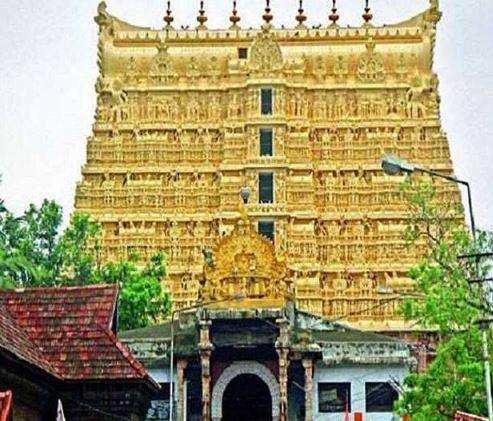Search here

23-May-2020
System For Hindu Temples Maintainence Should Be There
Senior Congress leader and former Maharashtra Chief Minister Prithviraj Chavan has prepared the prelude to a new polarization based on religion in Indian politics by saying that the gold lying in temples should be acquired. Prithviraj Chavan argues that according to the World Gold Council there is an estimated one trillion dollars (about Rs 76 lakh crore) of gold in the temples of the country.
Some time ago, a campaign to extract gold from the Hindu temple was started by the leftist lobby in social media. This included those who have no faith in temples and have nothing to do with Sanatan Hinduism and its rituals. The malaise towards Hindu temples is the root of the Congress's prejudice. Indira Gandhi's entry into the Jagannath temple was opposed due to this malice.
The greed of the wealth of temples is not without reason. The history of the Mughal period is witness to the breakdown of thousands of temples. After the arrival of the British in India, it was thought that the British would loot whatever was left of the Mughals, but due to the Hindu society's sense of going to any extent for the religion, the British took direct confrontation with this society. Instead of dividing it, adopt a policy of governance. The British made a law (Madras Hindu Temple Act 1843) to send the wealth of temples to London. The British failed due to the Revolt of 1857, yet they worked to control religious activities. Many laws were made for this such as Society Act, Trust Act. In 1923, the Madras Hindu Temple and Religious Place Endowment Act was enacted.
From 1920 to 1947, millions of hectares of land in India were leased to churches in the name of Charitable Trusts. After independence, the Congress moved forward on the visible path of the British. The Hindu Religious and Charitable Endowment Act, 1951 was replaced by the Madras Hindu Temple Act due to the interest of Prime Minister Jawaharlal Nehru. After this, independent India saw a new phase of misuse of the wealth of Hindu monasteries.
Article 29-30 of the constitution provided all the religious rights to the minorities with an independent system of their mosques, churches and education, but a gradual abolition of the religious education system dependent on Hindu monasteries. Every temple in India has a school, a hospital, a road to the village, that is, a contact road and a large campus of the temple and its Thakur Badi have been used for the rites that take place in every happiness and sorrow of the village. This was the great mantra of India's social unity, which was destroyed. To a lesser extent, the monasteries of South India are still doing work related to education and health, but there is a lack of this in the temples and monasteries of North India.
In 2012-13, the gold jewelery of the historic Padmanabha temple, under the control of the Government of Kerala, was calculated and assessed at about five lakh crore rupees. Despite the supervision of a person appointed by the Supreme Court, the valuation of crores of gold was stolen, while under the supervision of the priest and the Raja Ravi Burman family who built this temple, there was no news of the theft of ten grams of gold in thousands of years. Did not appear
Through the Hindu Religion Donation Act, 1951, the Congress gave authority to states that they could subdue any temple without assigning any reason. Since this law was made, the Andhra Pradesh government took over 34 thousand temples under its control. The annual revenue of Tirupati Balaji Temple is around Rs 3500 crores. Even after receiving this much money, only seven percent of the funds received by the Tirupati temple are returned for the maintenance of the temple. Precious gems of this temple have been found selling in UK markets. Former Andhra Pradesh Chief Minister YSR Reddy ordered five of the seven hills of Tirupati to be given to the government. The church was to be built on these hills. Eighty percent of the offerings to the temple are spent for non-Hindu works. The level of corruption in the donation of temples is that out of two lakh temples in Karnataka, about 50 thousand have been closed due to lack of maintenance.
Acharya Chanakya said that if any religion is to be abolished, then its shelter sites i.e. monasteries and temples etc. should be abolished. Today there are around nine lakh temples in India, out of which four lakh temples are with the government.
READ HERE MORE : Li Wenliang- The Chinese Whistleblower Which Told Us The Truth
Can a constitutionally secular head of state operate a temple, mosque, church, gurudwara, etc.? The gold of the temples is the property of Hindu society, not the government. Those who saw the wealth lying in the monasteries, do they not see the donations of millions and crores coming in the name of charity in the country?
Is this donation not used in conversion? Now the time has come that parallel to the powerful organization of churches, the management system of Hindu temples should be erected and the work of research and development in education, health and ancient sage tradition. The contribution of temples for this should be reflected.

Content Writer/Journalist
I am a content writter !
Join Our Newsletter
Subscribe to our newsletter to receive emails about new views posts, releases and updates.
Copyright 2010 - 2025 MindStick Software Pvt. Ltd. All Rights Reserved Privacy Policy | Terms & Conditions | Cookie Policy